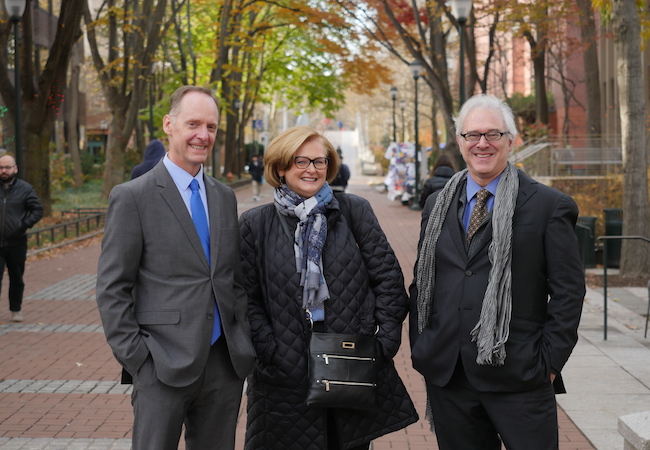What happens to education funding during the next recession?

Scott Pattison, former executive director of the National Governor's Association, and Penn GSE professors Joni Finney and Jonathan Supovitz during Pattison's recent visit to Penn.
When Scott Pattison, the former executive director of the National Governor’s Association, looks at the landscape for education funding, he sees troubling signs.
Revenue growth for local governments across the country is at its lowest rate since 2013. Property tax receipts are showing signs of weakening. Two-thirds of big cities are predicting a recession will hit in 2020 or 2021.
During a series of talks at Penn sponsored by Penn GSE’s Education Policy and Higher Education Divisions and the Wharton Public Policy Initiative, Pattison said higher education and K-12 leaders should start preparing for the next economic downturn now.
“The economy has been pretty good and revenue to state and local governments has been strong. But money for K-12 and higher education has still been pretty tight since the recession,” Pattison said. “And I think we’re about to turn a corner. We’re at an interesting moment where we can plan for the downturn, and hopefully not just have to make slashing cuts.”
Education officials need to understand how the political and fiscal environments have changed since the period before the great recession, Pattison said. Barring significant shifts, university chancellors and district superintendents should expect a different, perhaps painful response to the next recession.
The coming funding squeeze
After the great recession hit, the federal government propped up some state and local education budgets with stimulus funding. But things have changed.
Medicaid continues to consume a larger portion of the federal and state budgets. In the last two years, federal debt has doubled. And politicians from both parties have been reluctant to raise taxes.
“If there’s a downturn, I don’t expect the federal government to be as generous next time around,” Pattison said.
Education leaders will also be under more pressure to justify they deserve the money they do receive. University presidents, for example, should expect their graduation rates to come under more scrutiny. Leaders at all levels will be asked about preparing students for jobs, placing them in jobs, and creating jobs, Pattison said.
“I’ve seen a huge change in elected officials,” Pattison said. “They’ve gone from saying everyone should have a four year degree to saying there’s nothing wrong with a community college degree or being plumber’s apprentice. Because it’s all about the jobs.”
Opportunity for innovation
Not everything is bleak. Pattison noted that many states have been saving money in rainy day funds. Hopefully that cushion will help avert the worst cuts, especially if the next recession is not as severe as the one that began in 2007.
Budget cuts can also allow leaders to try innovative projects they otherwise might leave on the drawing board.
“There are opportunities here,” Pattison said. “I think it’s a time for the academy to think about how we can approach policies differently.”
Conduct research, but make an impact
Pattison has spent most of his career working with policymakers. During a question and answer session, he was asked how researchers can improve the odds that their work makes an impact on policy decisions.
It starts with a conversation,” Pattison said.
"Ask policymakers what they are interested in,” Pattison said. “If you are working with a school district, see if you can schedule a lunch to ask what they need and what would be helpful. See where your interests align."
Penn GSE professor Joni Finney agreed:
"If we begin to have these conversations, we can do research that is important and interesting, and know that there is an audience."
